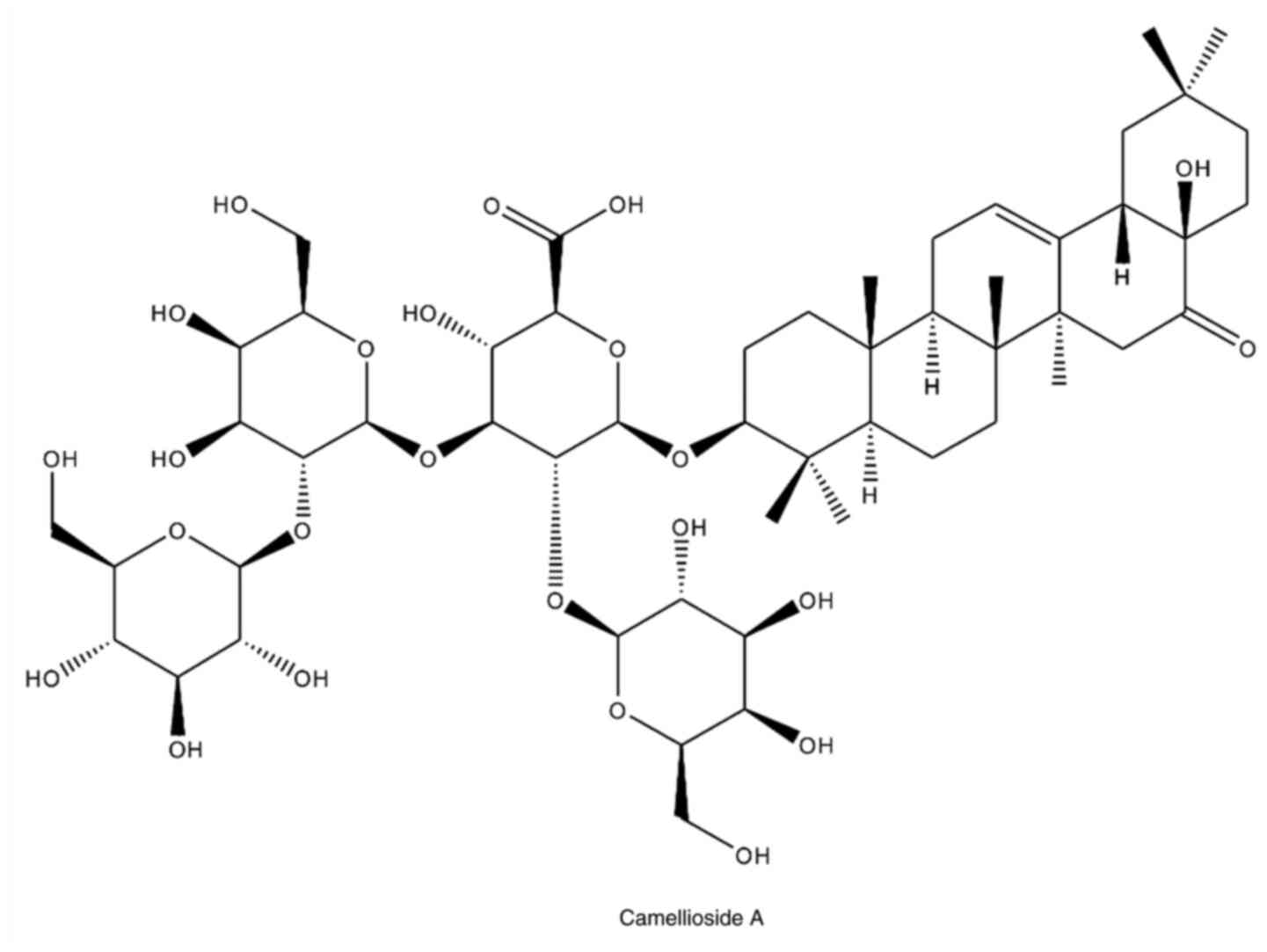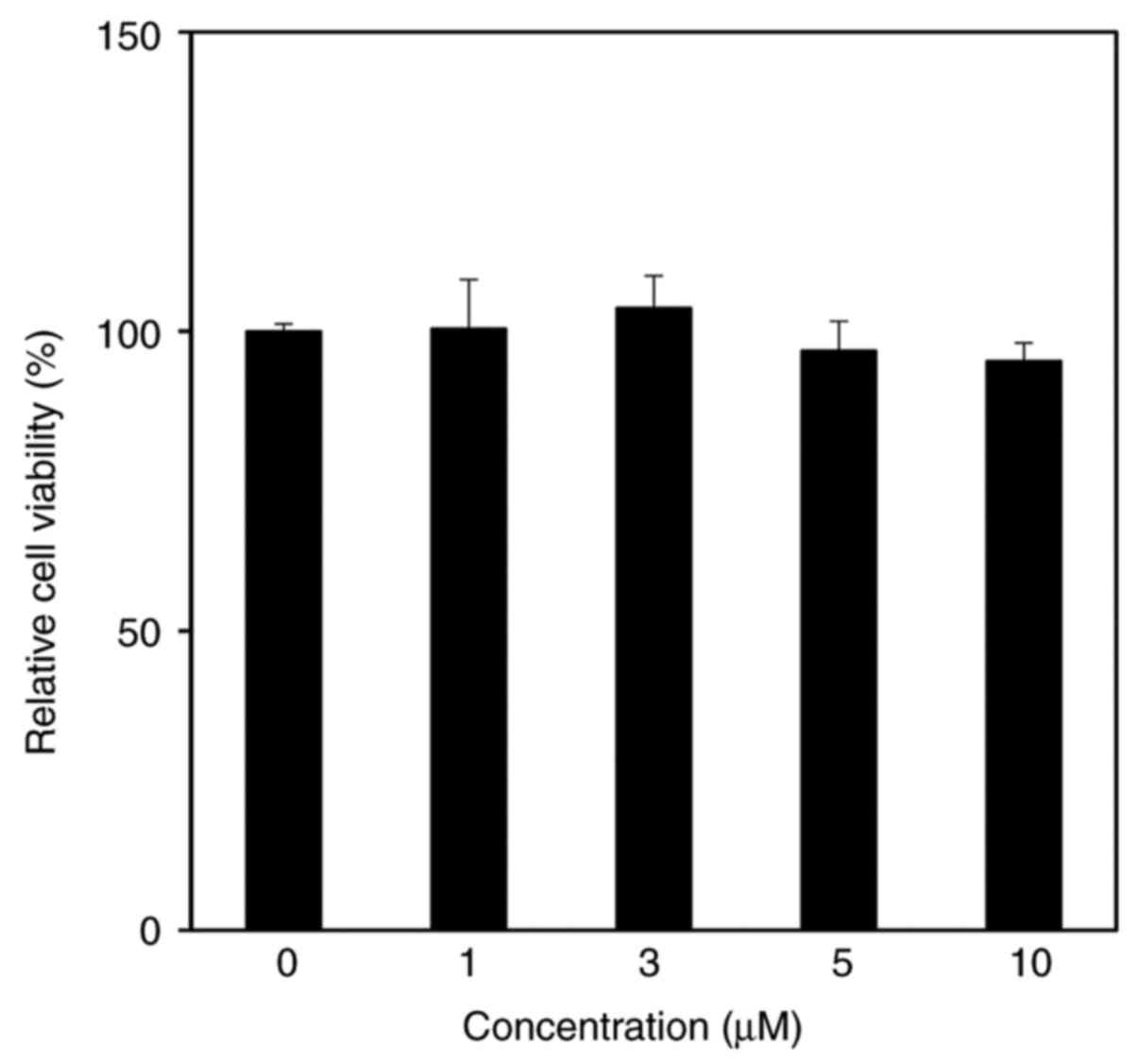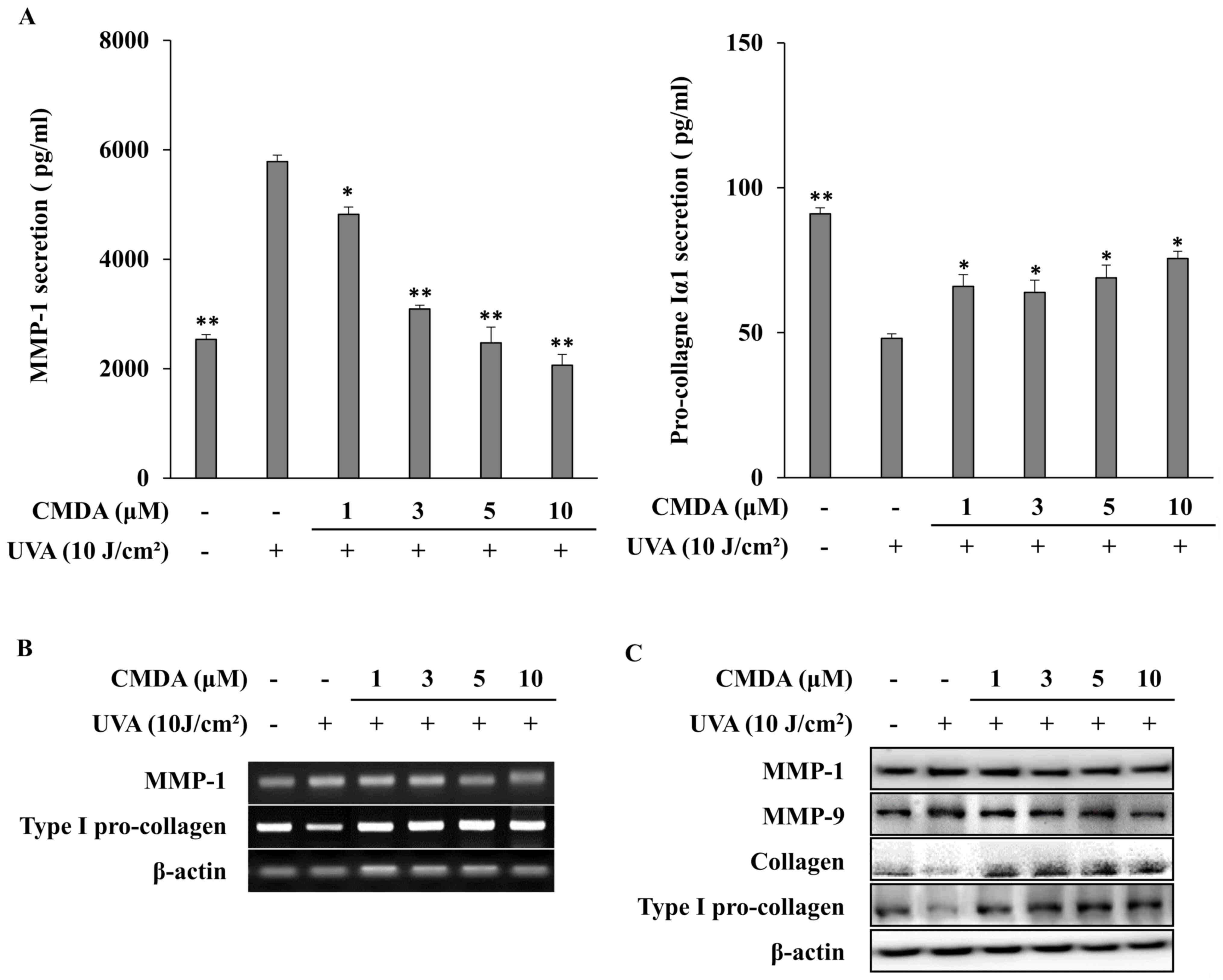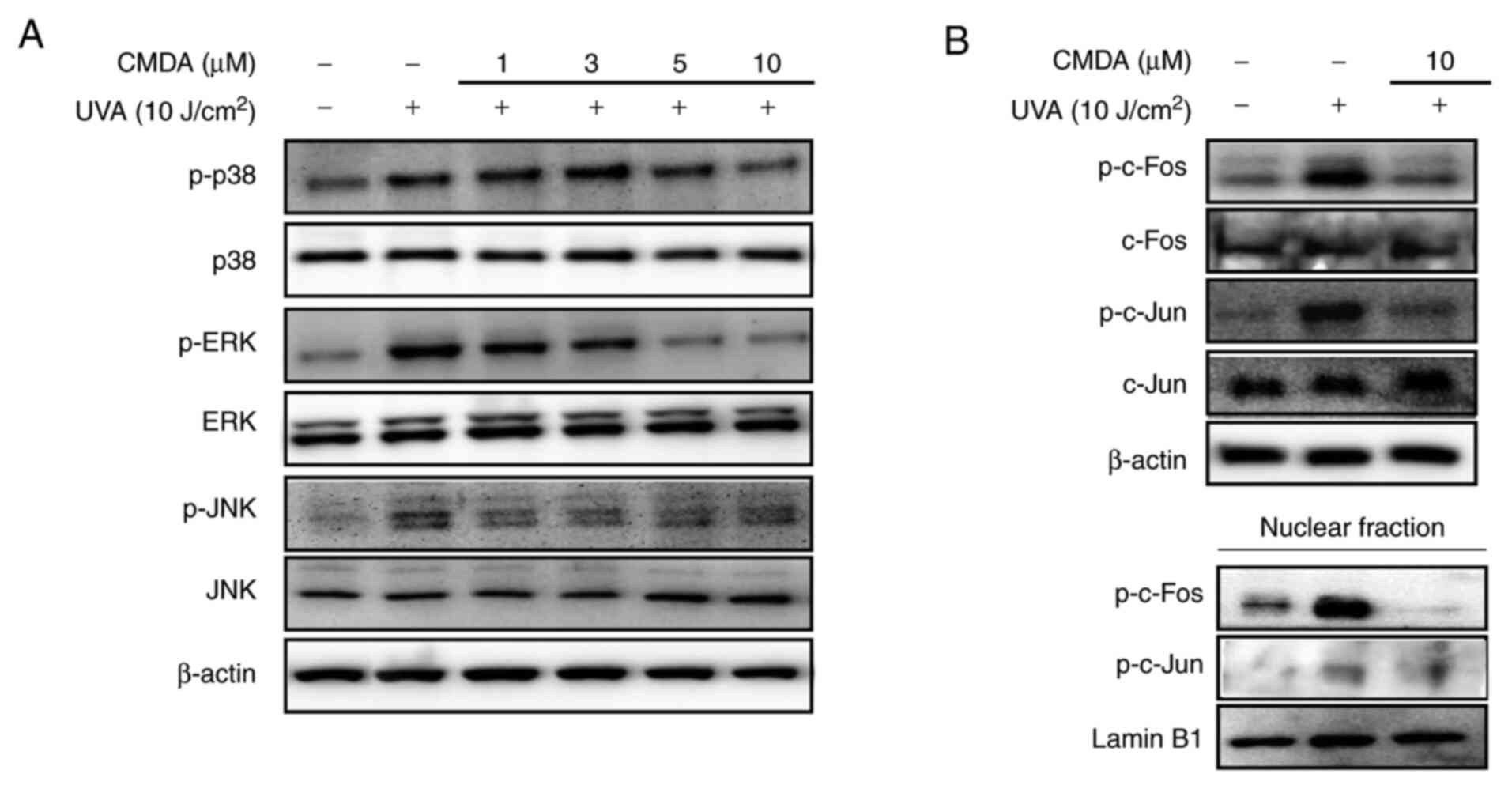Camellioside A, isolated from Camellia japonica flowers, attenuates UVA‑induced production of MMP‑1 in HaCaT keratinocytes via suppression of MAPK activation
- Authors:
- Fatih Karadeniz
- Jung Hwan Oh
- Hye Ran Kim
- Jaeyoung Ko
- Chang-Suk Kong
-
View Affiliations
Affiliations: Marine Biotechnology Center for Pharmaceuticals and Foods, College of Medical and Life Sciences, Silla University, Busan 46958, Republic of Korea, Department of Food and Nutrition, College of Medical and Life Sciences, Silla University, Busan 46958, Republic of Korea, Amorepacific Corporation R&D Center, Yongin, Gyeonggi 17074, Republic of Korea
- Published online on: November 5, 2020 https://doi.org/10.3892/etm.2020.9448
-
Article Number:
16
Metrics:
Total
Views: 0 (Spandidos Publications: | PMC Statistics:
)
Metrics:
Total PDF Downloads: 0 (Spandidos Publications: | PMC Statistics:
)
This article is mentioned in:
Abstract
Ultraviolet (UV) radiation is responsible for various damages to the skin, collectively referred to as photoaging. A key UV‑induced effect on the skin is excessive degradation of collagen and related structural abnormalities. Camellia japonica is a flowering plant with cosmeceutical properties. In the present study, Camellioside A (CMDA), a triterpene saponin, was investigated for its effects against UVA‑induced photoaging in HaCaT keratinocytes. CMDA was analyzed to determine its attenuating effects against UVA‑induced overproduction of the collagen degradation enzyme, matrix metalloproteinase‑1 (MMP‑1), in UVA‑irradiated immortalized human HaCaT keratinocytes. UVA irradiation significantly increased MMP‑1 release from keratinocytes in addition to suppressing type Iα1 pro‑collagen production. Treatment with CMDA reversed the effects of UVA irradiation on the production of MMP‑1 and type Iα1 pro‑collagen. UVA irradiation also stimulated the activation of p38, ERK and JNK mitogen‑activated protein kinases (MAPKs) and their downstream transcription factor activator protein 1 (a heterodimer of c‑Fos and c‑Jun). MAPK activation and consequent phosphorylation of c‑Fos and c‑Jun were also inhibited by CMDA treatment. In conclusion, the present study indicated that CMDA may have potential antiphotoaging properties due to suppression of UVA‑mediated MMP‑1 production.
View References
|
1
|
Dupont E, Gomez J and Bilodeau D: Beyond
UV radiation: A skin under challenge. Int J Cosmet Sci. 35:224–232.
2013.PubMed/NCBI View Article : Google Scholar
|
|
2
|
Widel M, Krzywon A, Gajda K, Skonieczna M
and Rzeszowska-Wolny J: Induction of bystander effects by UVA, UVB,
and UVC radiation in human fibroblasts and the implication of
reactive oxygen species. Free Radic Biol Med. 68:278–287.
2014.PubMed/NCBI View Article : Google Scholar
|
|
3
|
Battie C, Jitsukawa S, Bernerd F, Del Bino
S, Marionnet C and Verschoore M: New insights in photoaging, UVA
induced damage and skin types. Exp Dermatol. 23 (Suppl 1):S7–S12.
2014.PubMed/NCBI View Article : Google Scholar
|
|
4
|
Dong KK, Damaghi N, Picart SD, Markova NG,
Obayashi K, Okano Y, Masaki H, Grether-Beck S, Krutmann J, Smiles
KA and Yarosh DB: UV-induced DNA damage initiates release of MMP-1
in human skin. Exp Dermatol. 17:1037–1044. 2008.PubMed/NCBI View Article : Google Scholar
|
|
5
|
Duque L, Bravo K and Osorio E: A holistic
anti-aging approach applied in selected cultivated medicinal
plants: A view of photoprotection of the skin by different
mechanisms. Ind Crops Prod. 97:431–439. 2017.
|
|
6
|
Kim YH, Kim KS, Han CS, Yang HC, Park SH,
Ko KI, Lee SH, Kim KH, Lee NH, Kim JM and Son KH: Inhibitory
effects of natural plants of Jeju Island on elastase and MMP-1
expression. Int J Cosmetic Sci. 29:487–488. 2007.PubMed/NCBI
|
|
7
|
Nakamura S, Moriura T, Park S, Fujimoto K,
Matsumoto T, Ohta T, Matsuda H and Yoshikawa M: Melanogenesis
inhibitory and fibroblast proliferation accelerating effects of
noroleanane- and oleanane-type triterpene oligoglycosides from the
flower buds of Camellia japonica. J Nat Prod. 75:1425–1430.
2012.PubMed/NCBI View Article : Google Scholar
|
|
8
|
Panich U, Chaiprasongsuk A, Lohakul J,
Soontrapa K and Sampattavanich S: Photoprotective role of Nrf2 in
UVA-mediated MMP-1 via MAPK/AP-1 signaling in keratinocyte HaCaT
cells and mouse skin: The photoprotective effects of sulforaphane.
Free Radic Biol Med. 100(S44)2016.
|
|
9
|
Kim M, Son D, Shin S, Park D, Byun S and
Jung E: Protective effects of Camellia japonica flower
extract against urban air pollutants. BMC Complement Altern Med.
19(30)2019.PubMed/NCBI View Article : Google Scholar
|
|
10
|
Wang X and Bi Z: UVB-irradiated human
keratinocytes and interleukin-1alpha indirectly increase MAP
kinase/AP-1 activation and MMP-1 production in UVA-irradiated
dermal fibroblasts. Chin Med J (Engl). 119:827–831. 2006.PubMed/NCBI
|














